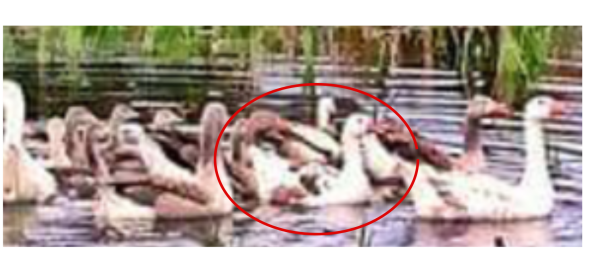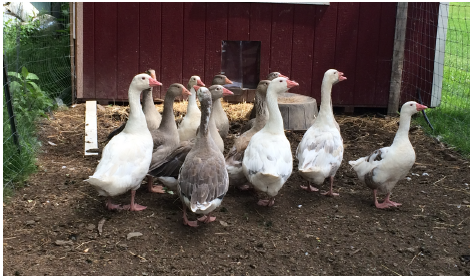In 2020 I purchased 2 pairs of geese. They were discovered in 2016. This is the provenance that goes back nearly 35 years. They have been flock-bred with no new blood. They have not had problems with birth defects of any kind.
Brandon Everette discovered these geese. This is his story.
On May 7th, 2016 I came across a photo of someone’s newly purchased “pilgrim” gaggle posted on a Facebook poultry group. I took the initiative to message her because I thought I could see a saddleback bird in the photo, which led me to be suspicious about the gaggle. She responded, “Yes you do. It’s a male pilgrim, with a saddle.”

Immediately I was a little enthusiastic, as this was clearly not a male pilgrim with a saddle. This appeared to be a gaggle of my most beloved race of geese, not too far away from home. I then asked how sure she was about the sex of the saddleback bird and what color the bills and feet were. She responded, “No not certain. More on the pink side, like my sebbies. This flock, 25 percent of the time throws this pattern.”
She said the flock has been closed for over 20 years.” In the circle is the saddleback bird that caught my attention amidst the otherbirds in the photo, which was originally posted on Facebook by the owner.I then requested photos of the birds and she sent some. The photos showed 14 geese with pink bills and feet, ranging in ages. There were three adult white birds, two adult saddleback birds, one very young saddleback bird, five adult grey birds, and three very young grey birds. Below are the photos she sent me of the gaggle:

On June 21st, 2016 I drove to her farm and spoke with her. At the time, she had nothing more to add about the geese than she had already discussed. However, she did tell me the name of the woman she purchased the gaggle from, but I was not able to get her contact information. I left her farm with a trio of birds, one white gander, one grey goose, and one saddleback goose (assumed younger than the other two, but not a gosling). There are photos on the next page I took of the whole gaggle at her farm, and of the trio after I purchased them.
I took these photos of the gaggle when I visited her farm in late June, 2016. I wanted to give the birds a thorough look over and confirm my suspicions (on a visual basis that had grown significantly. The grey goslings are mostly to the back left in these photos, and can be distinguished by a lack of white about their face or necks.

Unfortunately, the young saddleback had died before I visited the farm. One of the ganders had more grey about his body than the other two, but it was not unreasonable, and I could tell by his defensive posture, heightened chest, and high-pitched honking that the bird was a gander. Interestingly, he, like the other two ganders were significantly larger than the geese. This line appeared not to only be sexually dimorphic by plumage color, but also by size. This is not necessarily atypical of geese, as ganders are often larger. The saddleback geese and grey goose with the most white about her head and neck were the smallest of the bunch.
On July 16th, 2016 The gaggle owner answered my message in which I inquired about any other word from the original owner on the origin of the gaggle. She wrote back, “The lady I got them from said she purchased the entire flock [of] the pilgrims and two English saddlebacks from a lady down in the Philadelphia area she cannot remember her name and does not have contact information. The lady she got them from told her what they were when she purchased them that they were the last of her remaining flock.”
One July 18th, 2016 I contacted her again and asked her which previous owner had the flock for 20+ years. She responded with [name omitted for privacy] has had this flock for 6 years. The other lady [from Philadelphia] had the closed flock for 20+ years.”
Shortly after visiting her farm and purchasing the trio, she sold a few of the other geese: one gander, and three grey geese (4 total); leaving her with a gander, a saddleback goose, and five grey geese (6 total). I have no record of who purchased those birds, but I have little faith they became a part of any conservation-breeding project because she sold them as Pilgrims and not Old English geese (I think at this point, she thought I was crazy and following some romantic fantasy of discovering these geese that she has never even heard of). So, at this point, there were only two ganders, two saddleback geese, and six grey geese (9 total) that could be used to repopulate this line. I eventually revisited her farm and purchased a second grey goose, giving me a total of 4 birds to use for my breeding project.
Breeding in the spring of 2017 was very successful, with a healthy brood of goslings. You can see the gaggle pictured here, proudly walking with their brood. While I did have some goslings hatch in both 2018 and 2019, I did not have as many as 2017. I believe this was mostly due to my increase in number of birds (saved some from the 2017 hatch) and with that increase in habits such as territorial disputing, and nest sharing. It was, of course, my own fault for failing to provide enough secluded spaces. I never separating the flocks for breeding purposes, they ran open. I say “flocks” because I raised the Norman line of Old English geese from 2013 until winter of 2016, but I never let the two intermingle in their short time together. I wanted to keep line as pure as possible.

My observations about the line Like most geese, the parents in this line are very defensive, and with the size of the ganders possibly exceeding 16lbs, they can be a force to be reckoned with during breeding season. That said, the line has proven to be exceptional at parenting in my experience. The geese are diligent about their goslings, and rarely displayed any signs of aggression towards goslings that were not their own. For my incubator-raised goslings, I found ganders to be excellent foster parents, as the females rarely accepted them unless the timing of their hatch was almost perfectly aligned with their own brood, and I could slip the gosling under at night.
The young birds, and lighter mature females can fly a decent distance. I had more than one on occasion scare me as they flew across a road. I consider flight a valuable trait in geese, and a characteristic that cotton patch/old English/early American geese (whatever you want to call them) should have (with the exception of mature heavy birds, or very old birds).
Weighs vary greatly. My smallest bird, the saddleback in my original trio, weighed 8.5lbs, whilst her mate nearly doubled it, at 16lbs. The males were always heavier than the females, though ganders under 2 years of age may be smaller than some mature females until they fully mature. Bills and feet are always pink. I never hatched a bird with any orange in the bill or feet. I consider orange to be a sign of crossbreeding in the past, so I am relieved to say that after 3 seasons of breeding, including from my newer generations, I saw no orange or other signs of cross breeding/contamination of the genetics by foreign breeds.
They are very hardy in heat or cold. Minimal winter shelter is required. They are also excellent foragers. I found them to be excellent birds for slaughter as well, and we had one every Christmas while I raised geese. The meat is tender, sweet, and the layer of fat is perfectly proportionate. You can get a good amount of fat of off one bird, to be used as lard for other cooking projects.
I never did weigh the eggs, but they were the same general size as the eggs from the Norman line birds I had prior. The goslings were generally hardy, vigorous, and active. Sexing was never hard, as the distinctions between them are as should be for these autosexing landraces. Like most lines of these geese, the grey form female goslings are a dark, olive-green/grey color with dark bills and feet, whilst the ganders are light greenish-blonde, with pinkish bills and feet. The pied (saddleback) form female goslings have a dark, distinct saddleback pattern at hatch, with bicolored bills and feet (pink and grey), whilst the ganders are a lighter form, with a light grey saddle pattern and purely pink bills and feet.
Adult ganders may show some grey in the plumage, but I never had one that I thought was terribly excessive or lacking on the dimorphic quality.
